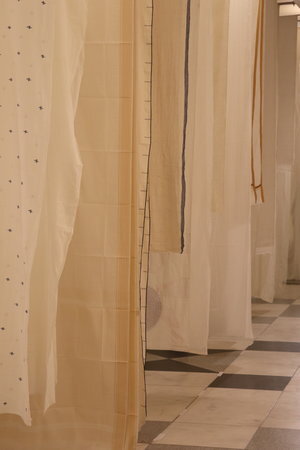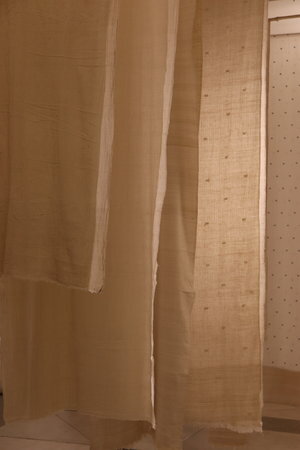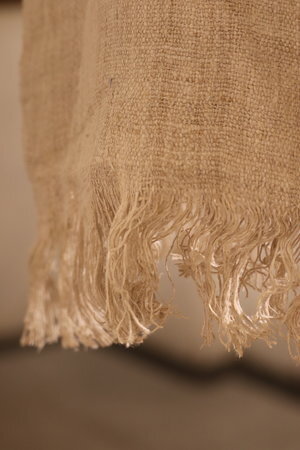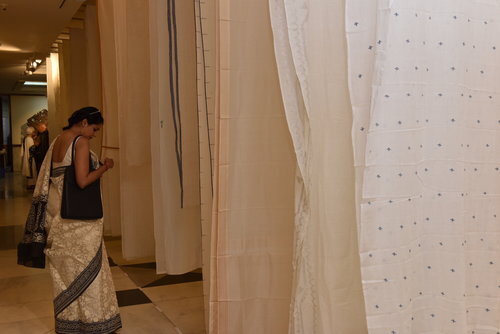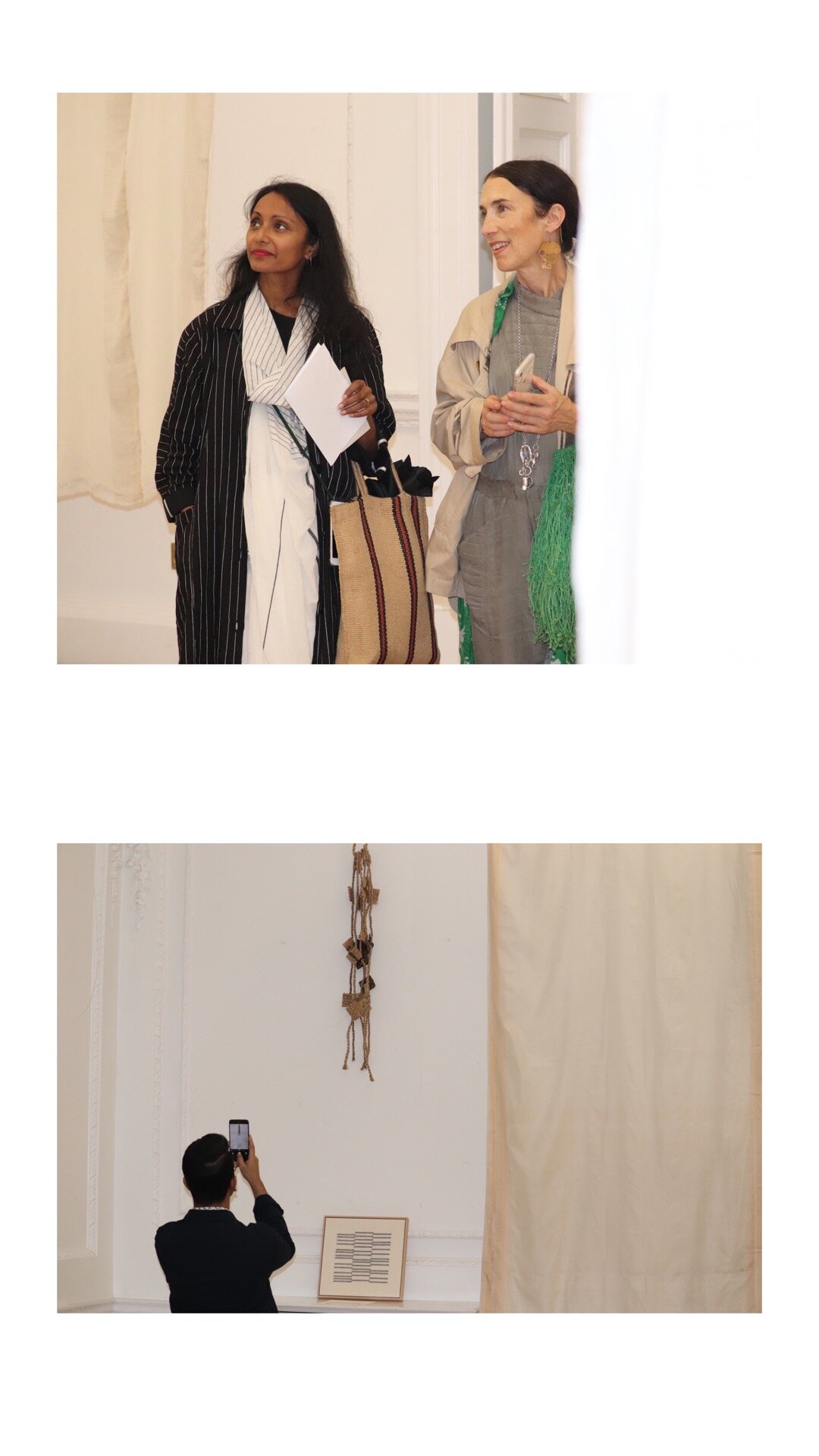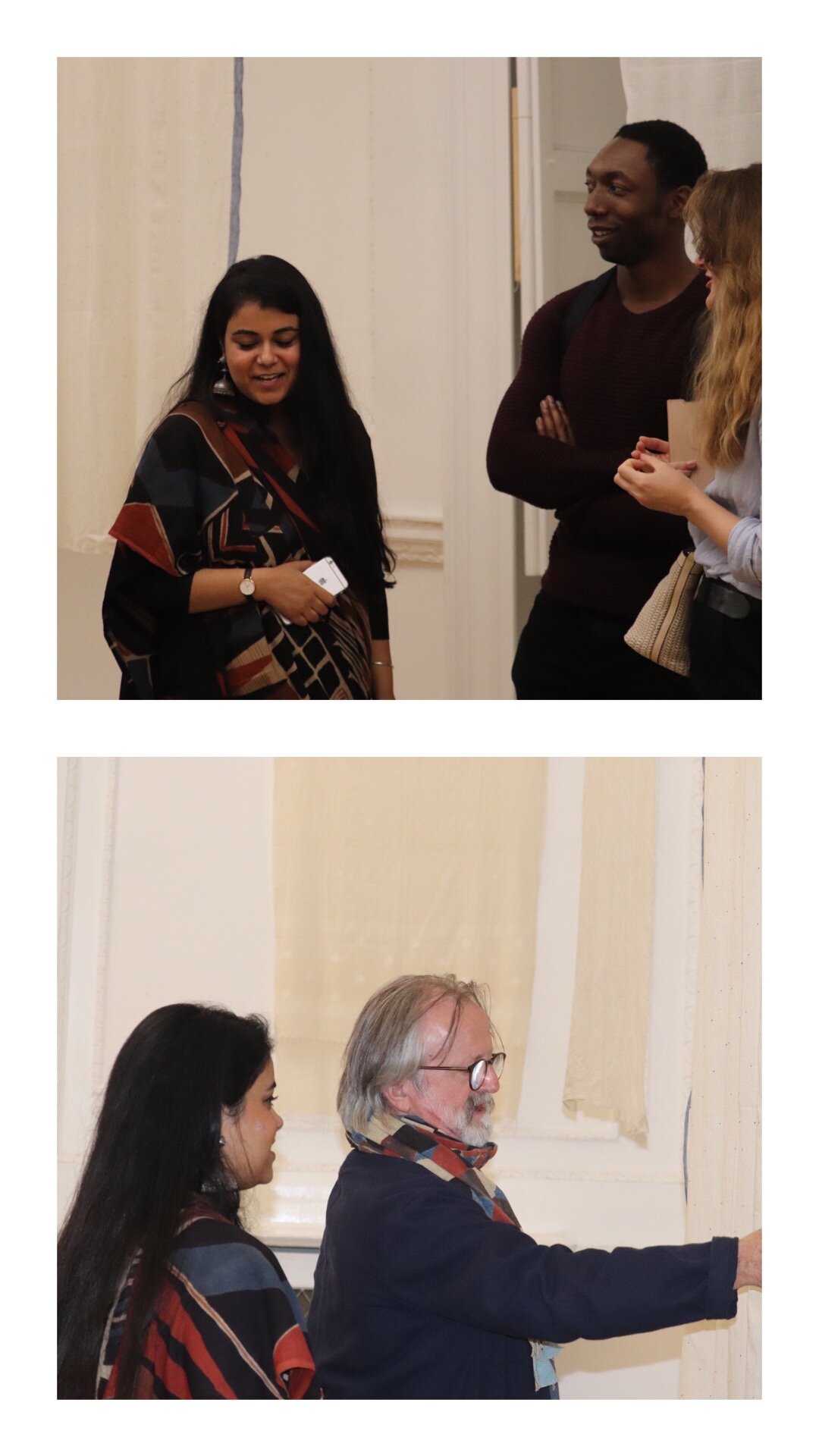SAFED | A textile installation exploring Khadi
SAFED is a textile installation that was curated as part of the Craft Project. The project documented tangible anthropology i.e material culture of a place and comment on its relevance in the contemporary space. It also celebrates diversity in culture through objects, folk arts, crafts, and design.
Concept by Sayali Goyal
While travelling to different textile regions in India, I was always fascinated with the workshops and homes of dyers, embroiders and weavers. Some of these workshops had loose white fabric hung for natural bleaching, and this experience evoked almost a spiritual feeling in me. I wish to translate this experience for the viewer.
A common string in most textile crafts of India is white fabric, a blank canvas. Through this project, I also wish to showcase the unity of our craftsmen yet bring out the diversity in textures. When a weaver weaves fabric, a little bit of himself is woven into it as well, thus each fabric displayed here holds the artisan's emotions as if the artisan was present here. If you look carefully at these fabrics, they are all different and unique and have an individual soul yet we can appreciate them as one, just like Indian crafts.
EDIT ONE/ Key Observations from the Panel Discussion held at IGNCA, New Delhi, April 2019
We don't have so many cotton growing areas in the world and India exports most of it’s produce. Hence, the resources are limited but the demand for handwoven is a lot more, making it expensive to buy. In Bihar, there is a lot of traditional clothing but in a Surati bazaar you only find synthetic as there is no reach for handwoven fabric to smaller towns. In Kutch, synthetic fabric is becoming common in traditional communities. Pure Cotton is for the educated and the ones who can afford it. How sustainable is cotton really? Considering the amount of water it takes and where is all the cloth going after use?
Swedish school of textiles researched on sustainability and thinks that the solutions is to reduce consumerism and appreciate slow life that can be seen through craft. India might be the largest consumer of fast fashion which will have its implication on the environment as well as humans. We actually have it in our hands to change things by understanding the potential and value of handicrafts. In Europe people consider it luxury to own a piece of craft. Thus it is important to preserve the knowledge we have but also create value by positioning it as a luxury. Efforts have to be made to reposition crafts and understand how we can educate future consumers. Awareness and storytelling through brands is a solution.
It is crucial to understand artists and their life and root level problems. The reason these initiatives want to promote designers who work with crafts as it will encourage the new generation to stay in the business and also we culturally sustain them. Design is important as it will create an aspirational market and because of social media, there is cross-cultural exchange. Innovation is needed. Positive aspects: New people want to join the community and train in craft as it can offer economic sustainability. The artist himself needs to be proud of his own craft and culture. Future is design education to these communities for better prices. Ajrakh community is an example who have been able to adapt to this evolution. Some luxury designers are creating that value to craft example Sanjay Garg through Raw Mango. Luxury is a perception and design intervention that value addition can happen.
The Material library at Cocoa and Jasmine will contribute to grow for our future installations. If you are a maker, designer or organisation working with Handspun and Handwoven textiles from India, please email us on sayali@cocoaandjasmine.com to contribute.
We are open to installing in galleries and cultural centres.To host our exhibition, write to us at sayali@cocoaandjasmine.com
EDIT TWO / SEEN ABOVE IS THE INSTALLATION FROM LONDON DESIGN FESTIVAL 2019 at Nehru Centre, Mayfair
CONTRIBUTORS
Natural Lamb’s Wool, Handspun and Handwoven by Jigmat Couture, Changthang Ladakh
Natural Eri Silk, Handwoven by 7weaves, Contributed by Handwork Studio, Assam
Khadi with Block Print using discharge print technique, Contributed by Tharangini co
Maheshwari Cotton Silk Sari with a Zari Hansa Border, contributed by Rehwa Society, Madhya Pradesh
Handspun and Handwoven Kala Cotton, Contributed by Indigo Armour, Bhuj
Silk Linen from the Krishna Leela collection by Amba weave, Maheshwar
Pashmina, Handspun and Handwoven by Lena Ladakh, Changthang Ladakh
Cotton textile co-created with the weavers of Balaghat, Handwoven on an indigenous loom using fine handspun cotton and the selvage extensions has been figured using supplementary weft. Designed and Contributed by Sayan Chanda, Madhya Pradesh
Tangaliya/ Daana weaving on Kala Cotton, Made on a traditional Handloom, Contributed by Msafiri, Kutch
Kora Khadi, Handwoven in Gram Seva Mandal, Gopuri, (cotton comes from Khadi commission authorized plant Thrissur, Kerala) contributed by The Indian Sparrow
Kora Fabric, Handwoven in the Kodai Road cluster near Dindigul. The yarn is handspun on the Ambar Charkha by women across Tamil Nadu and woven on a frame loom using a bamboo reed, Contributed by Gandhi Gram, Tamil Nadu
Handwoven Cotton Mundu, Contributed by Kalki, Tamil Nadu
Handwoven Jamdani Muslin, Contributed by Biome Conscious Textiles, Bengal
Handwoven Cotton made by a female weaver cooperative, Contributed by Sonica Sarna, Kannur
A recreated white sari that incorporates Odisha’s Pipli applique with Japanese Origami on cotton fabric waste, Contributed by Revastra

